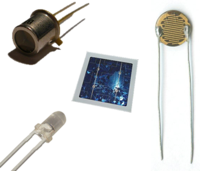
Photo from wikipedia
Single-walled carbon nanotube (SWCNT) functionalized with Pd nanoclusters have been shown experimentally to be effective H2S gas sensors. To this end, we have modeled a field-effect transistor with semiconducting SWCNT… Click to show full abstract
Single-walled carbon nanotube (SWCNT) functionalized with Pd nanoclusters have been shown experimentally to be effective H2S gas sensors. To this end, we have modeled a field-effect transistor with semiconducting SWCNT functionalized with palladium nanoclusters as the channel. Using non-equilibrium Green’s function method combined with density functional theory, we have investigated the effect of Pd nanoclusters on the electrical properties of the device and the sensing ability of the device as an H2S gas sensor at zero bias voltage. We have modeled two devices, one with Au electrodes and the other with SWCNT electrodes to show the effect of Au electrodes on the electrical properties of the device. In order to analyze the reason for the changes in the electrical properties of the device, charge transfer and electrostatic potential of the system are investigated. Results show that in both devices, functionalization with Pd nanoclusters results with the accumulation of charge on the channel while H2S adsorption causes charge depletion in the channel. In all cases, both charge transfer and electrostatic gating are responsible for the changes in the charge-carrier concentration in the channel. Due to significant changes in the electrical properties of the device after H2S adsorption, detection is possible with high sensitivity. Graphical abstract Graphical abstract
Journal Title: Journal of Nanoparticle Research
Year Published: 2020
Link to full text (if available)
Share on Social Media: Sign Up to like & get
recommendations!